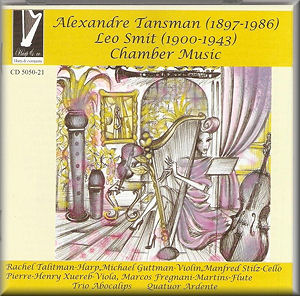 |
 |
|


CD: AmazonUK
|
Leo SMIT (1900-1943)
Trio for flute, viola and harp (1928) [14:52]
Quintet for violin viola, cello, flute and harp (1928) [21:10]
Alexander TANSMAN (1897-1986)
Alla Pollaca [1:57]
Suite pour Trio d’anches (1949) [9:58]
Sonatina da Camera, for violin, viola, cello, flute and harp [14:44]
Trois Pièces, for harp, clarinet and string quartet (1970) [8:57]
 Rachel Talitman (harp); Michael Guttman (violin); Pierre-Henry Xuereb
(viola): Manfred Stilz (cello); Marcos Fregnani-Martins (flute):
Jean-Luc Votano (clarinet); Trio Abocalips (Jean-Luc Votano (clarinet),
Sébastien Guedj (oboe); Joanie Carlier (bassoon))
Rachel Talitman (harp); Michael Guttman (violin); Pierre-Henry Xuereb
(viola): Manfred Stilz (cello); Marcos Fregnani-Martins (flute):
Jean-Luc Votano (clarinet); Trio Abocalips (Jean-Luc Votano (clarinet),
Sébastien Guedj (oboe); Joanie Carlier (bassoon))
Quartet Ardente (Ales Ulrich and Audrey Gallez (violins); Sarah
Charlier (viola); Olivier Vanderschaeghe (cello))
rec. 2010
 HARP & COMPANY CD-5050-21 [72:42]
HARP & COMPANY CD-5050-21 [72:42] 
|
|
|
These near contemporaries share a gravitational pull – actual
and stylistic in Smit’s case - toward Paris. Both were Jews,
Smit being Dutch of Portuguese descent and Tansman, very much
the better known, Polish.
Smit moved to Paris in 1927. He returned to Amsterdam a decade
later but in 1943 he was transported to Sobibor where he was
killed shortly after arrival. His Trio for flute, viola and
harp dates from 1928 and is a single movement of changing moods,
a refined nocturnal leading on to little, almost military calls,
and then ensuing Ravelian hues. Smit ensures that colours and
textures change, so that there are little soloistic moments,
rich arpeggios for the harp and a warmly textured slow section.
The Quintet dates from around the same time. Again it’s almost
explicitly devoted to Ravel’s methodology in texture and mood,
though it does tend to the more crepuscular. Cleverly it gathers
pace, then slackens, trading on an evocative sense of timbre
and colour more than the actual distinction of the melody lines
themselves.
Tansman is represented by a quartet of pieces of varying dimensions.
His Alla Pollaca is enjoyable and slight, lasting barely two
minutes. More substantial is the Suite, which has been accorded
several recordings. This work for wind trio (1949) is a perky,
Stravinskian affair with a wistful neo-baroque Aria and a bubbly
bassoon-led finale cross-pollinated by the chatter of the oboe
and clarinet; all reconciled very adeptly, and quietly. It’s
a fine work, characterful and clean. The Sonatina da Camera
for violin, viola, cello, flute and harp is a lissom work that
embraces a delicate nocturnal and is stamped, as was Smit, by
Ravel’s mark. There’s considerable, rapt simplicity, as well
as some high spirits, unleashed in the Finale (mistakenly tracked
13 on the jewel box – beware, it’s 12). Once again things are
clear, clean, with a Gallic ethos meeting the rhythmic pungency
of Stravinsky. Finally we have the Trois Pièces, for harp, clarinet
and string quartet, written in 1970. The first is languorous
and leisurely, whilst the second could go a touch faster than
it does in this performance. The final piece opens with a brief
but effective Lento section, and then launches off into affirmative
dynamism.
There have been a number of recordings of the Tansman pieces,
but Smit has been much less well represented on disc. The performances
here are generally fine – though sometimes things could be etched
with a degree more animation. The layout of booklet and box
is a bit of a mess, but you should certainly be prepared to
overlook that if in pursuit of this repertoire.
Jonathan Woolf
|
|

